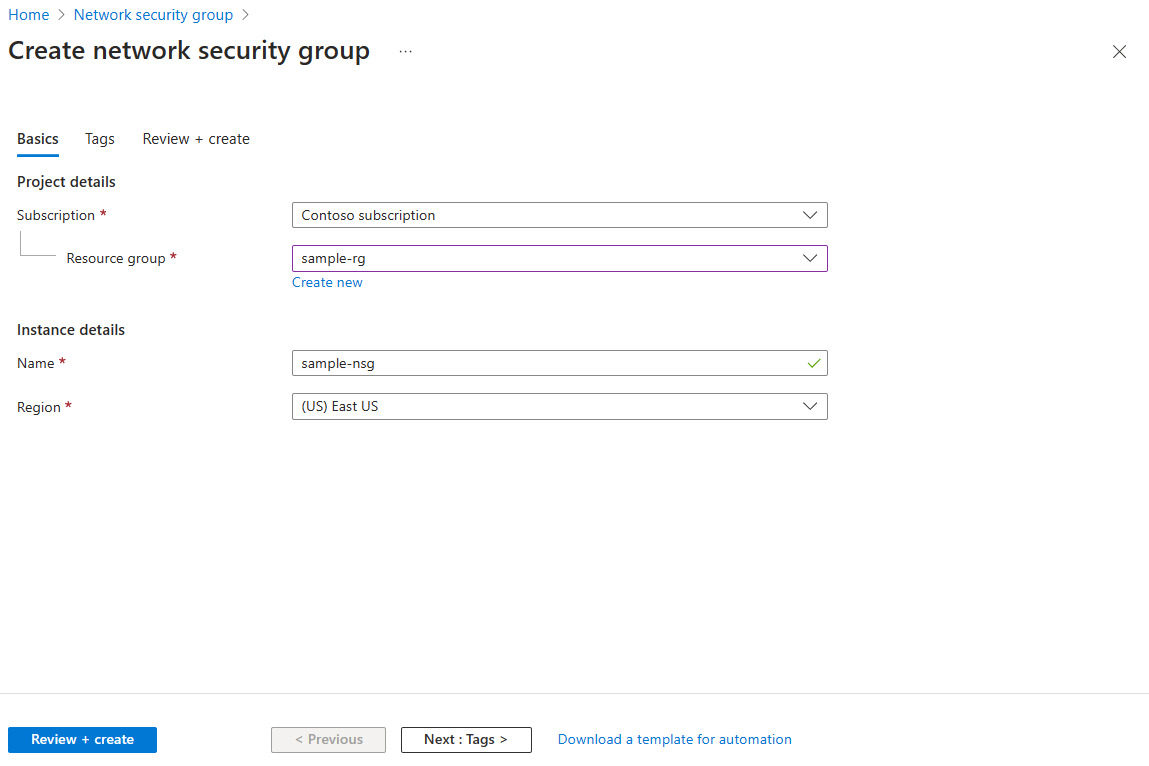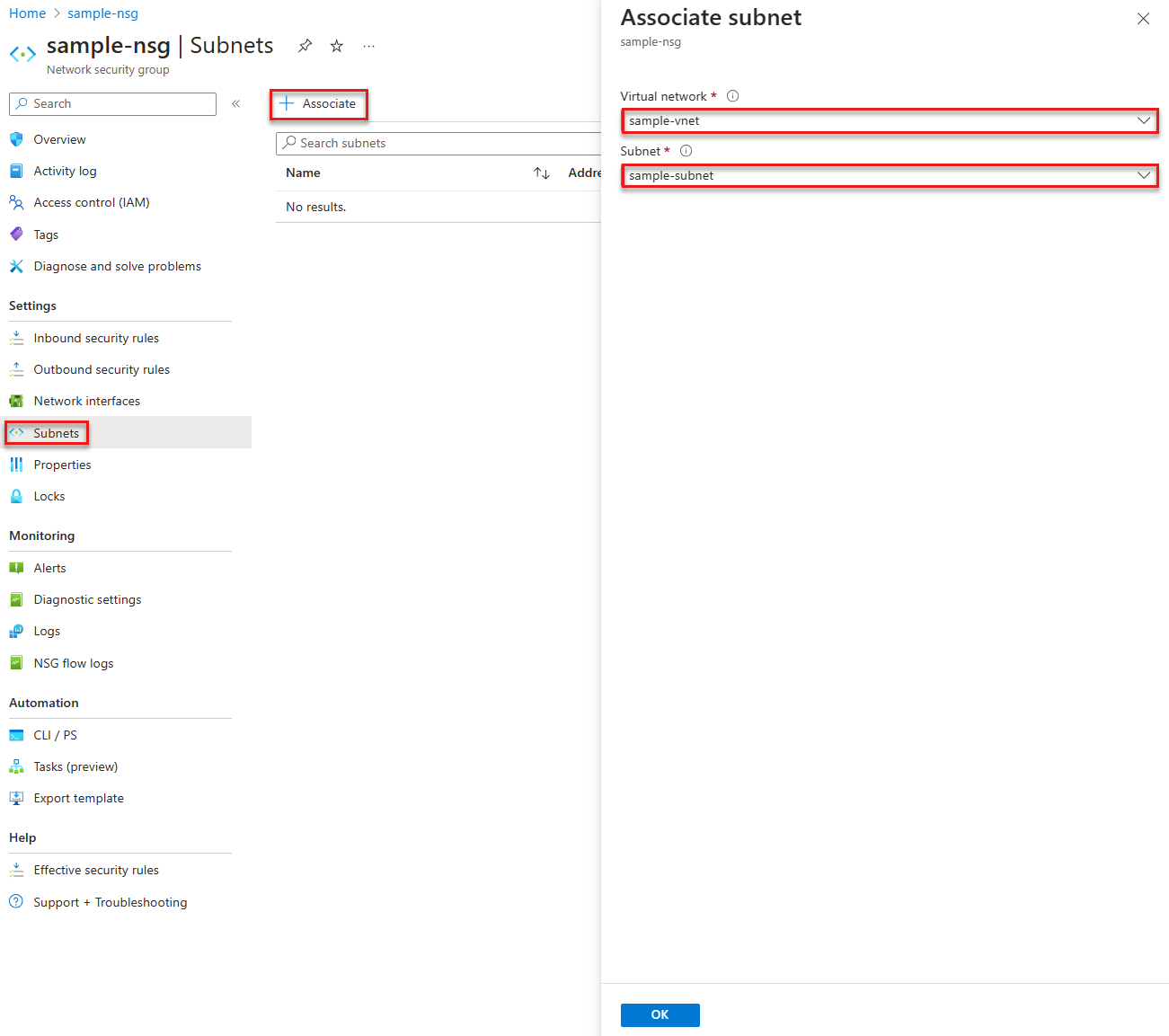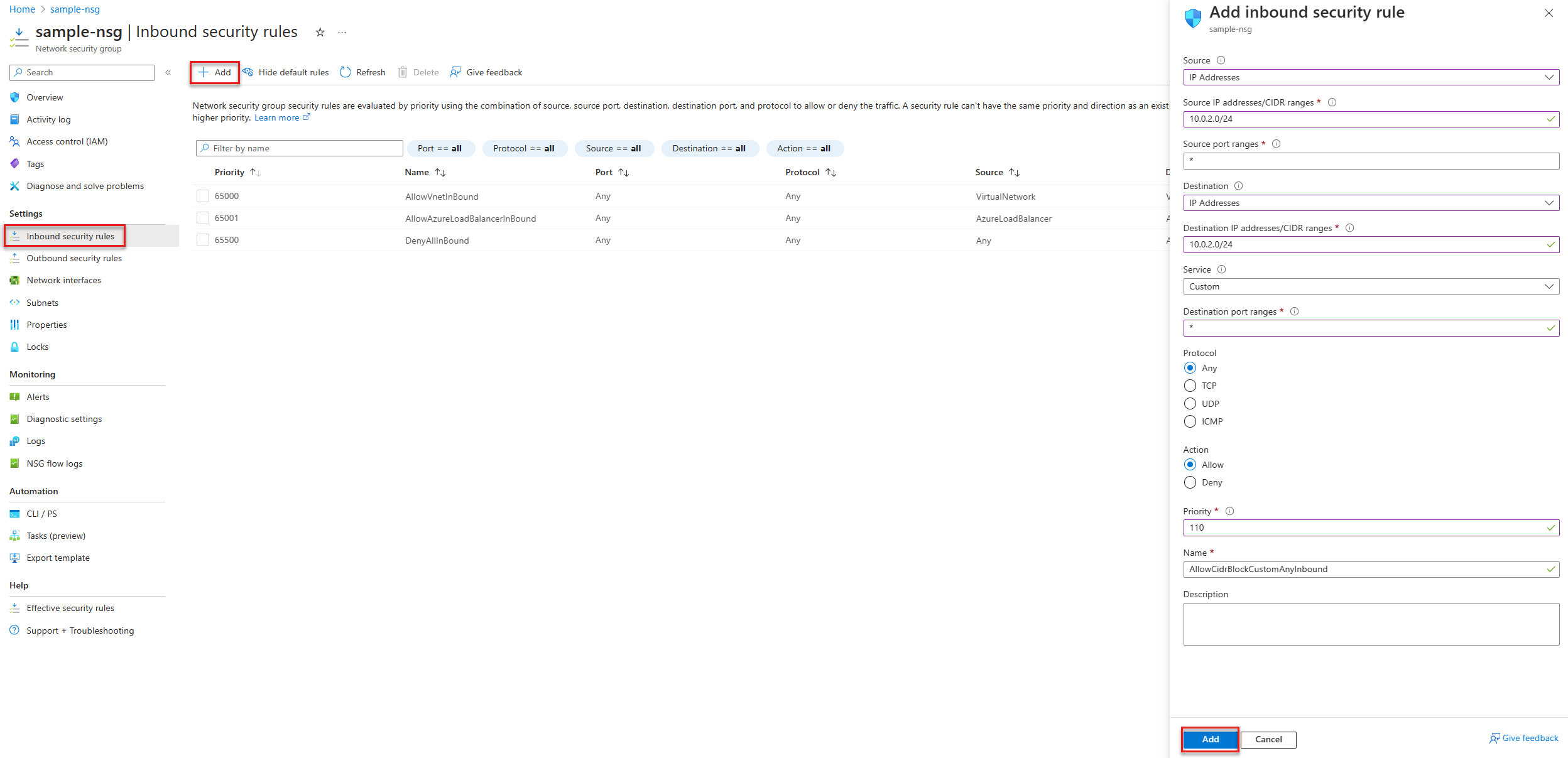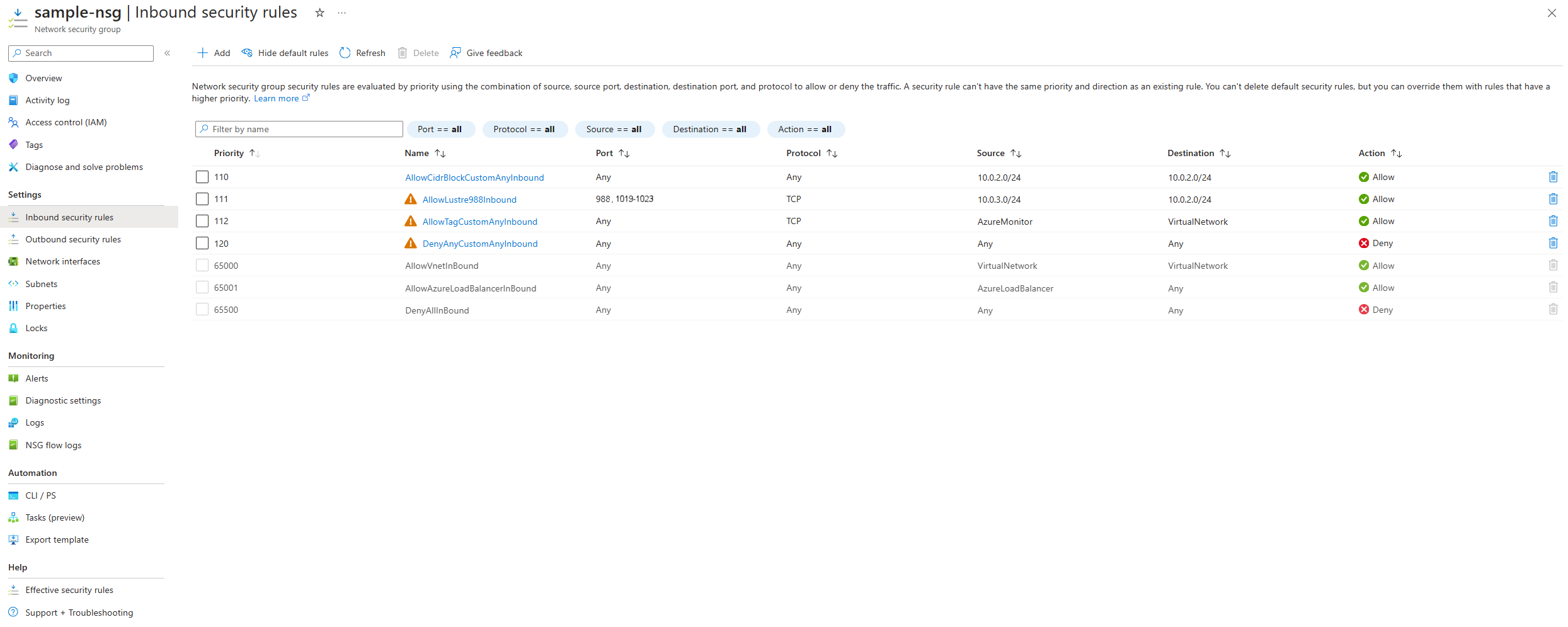Note
Access to this page requires authorization. You can try signing in or changing directories.
Access to this page requires authorization. You can try changing directories.
Network security groups can be configured to filter inbound and outbound network traffic to and from Azure resources in an Azure virtual network. A network security group can contain security rules that filter network traffic by IP address, port, and protocol. When a network security group is associated with a subnet, security rules are applied to resources deployed in that subnet.
This article describes how to configure network security group rules to secure access to an Azure Managed Lustre file system cluster as part of a Zero Trust strategy.
Prerequisites
- An Azure subscription. If you don't have an Azure subscription, create a free account before you begin.
- A virtual network with a subnet configured to allow Azure Managed Lustre file system support. To learn more, see Networking prerequisites.
- An Azure Managed Lustre file system deployed in your Azure subscription. To learn more, see Create an Azure Managed Lustre file system.
Create and configure a network security group
You can use an Azure network security group to filter network traffic between Azure resources in an Azure virtual network. A network security group contains security rules that allow or deny inbound network traffic to, or outbound network traffic from, several types of Azure resources. For each rule, you can specify source and destination, port, and protocol.
To create a network security group in the Azure portal, follow these steps:
In the search box at the top of the portal, enter Network security group. Select Network security groups in the search results.
Select + Create.
In the Create network security group page, under the Basics tab, enter or select the following values:
Setting Action Project details Subscription Select your Azure subscription. Resource group Select an existing resource group, or create a new one by selecting Create new. This example uses the sample-rg resource group. Instance details Network security group name Enter a name for the network security group you're creating. Region Select the region you want. Select Review + create.
After you see the Validation passed message, select Create.
Associate the network security group to a subnet
Once the network security group is created, you can associate it to the unique subnet in your virtual network where the Azure Managed Lustre file system exists. To associate the network security group to a subnet using the Azure portal, follow these steps:
In the search box at the top of the portal, enter Network security group and select Network security groups in the search results.
Select the name of your network security group, then select Subnets.
To associate a network security group to the subnet, select + Associate, then select your virtual network and the subnet that you want to associate the network security group to. Select OK.
Configure network security group rules
It's important to follow the minimum provided guidelines when you configure your network security group. Proper network security group configuration enables Azure Managed Lustre to operate essential services like the Lustre protocol, engineering and diagnostic support, Azure Blob storage, and security monitoring. Disabling any of these essential services may lead to a degraded product and support experience.
To configure network security group rules for Azure Managed Lustre file system support, add inbound and outbound security rules to the network security group associated with the Azure Managed Lustre subnet. The following sections describe how to create and configure the inbound and outbound security rules that allow Azure Managed Lustre file system support.
Note
The security rules shown in this section are configured based on an Azure Managed Lustre file system test deployment in the East US region, with Blob Storage integration enabled. You need to adjust the rules based on your deployment region, virtual network subnet IP address, and other configuration settings for the Azure Managed Lustre file system.
Create inbound security rules
You can create inbound security rules in the Azure portal. The following example shows how to create and configure a new inbound security rule:
- In the Azure portal, open the network security group resource you created in the previous step.
- Select Inbound security rules under Settings.
- Select + Add.
- In the Add inbound security rule pane, configure the settings for the rule and select Add.
Add the following inbound rules to the network security group. A description of all Azure service tags can be found at Azure Service Tags Overview.
| Priority | Name | Ports | Protocol | Source | Destination | Action | Description |
|---|---|---|---|---|---|---|---|
| 110 | rule-name | Any | Any | IP address/CIDR range for Azure Managed Lustre file system subnet | IP address/CIDR range for Azure Managed Lustre file system subnet | Allow | Allow traffic flow between Azure Managed Lustre hosts for file system activities. The system also requires TCP port 22 (SSH) for initial deployment and configuration. |
| 111 | rule-name | 988, 1019-1023 | TCP | IP address/CIDR range for Lustre client subnet | IP address/CIDR range for Azure Managed Lustre file system subnet | Allow | Allow your Lustre clients to interact with all Azure Managed Lustre storage nodes for file system activities. The Lustre file system protocol requires ports 988 and 1019-1023. |
| 112 | rule-name | Any | TCP | AzureMonitor |
VirtualNetwork |
Allow | Allow the AzureMonitor service to detect health or security issues with the Azure Managed Lustre service hosts. |
| 120 | rule-name | Any | Any | Any | Any | Deny | Deny all other inbound flows. |
The inbound security rules in the Azure portal should look similar to the following screenshot. The screenshot is provided as an example; consult the table for the complete list of rules. You should adjust the subnet IP address/CIDR range and other settings based on your deployment:
Create outbound security rules
You can create outbound security rules in the Azure portal. The following example shows how to create and configure a new outbound security rule:
- In the Azure portal, open the network security group resource you created in an earlier step.
- Select Outbound security rules under Settings.
- Select + Add.
- In the Add outbound security rule pane, configure the settings for the rule and select Add.
Add the following outbound rules and network service tags to the network security group. A description of all Azure service tags can be found at Azure Service Tags Overview.
| Priority | Name | Ports | Protocol | Source | Destination | Action | Description |
|---|---|---|---|---|---|---|---|
| 100 | rule-name | 443 | TCP | VirtualNetwork |
AzureMonitor |
Allow | Allow the AzureMonitor service to report health or and security issues diagnosed with the Azure Managed Lustre service hosts. |
| 101 | rule-name | 443 | TCP | VirtualNetwork |
AzureKeyVault.EastUS |
Allow | Allow access to AzureKeyVault, which the service uses to store essential security secrets needed for basic operation and storage access. |
| 102 | rule-name | 443 | TCP | VirtualNetwork |
AzureActiveDirectory |
Allow | Allow access to AzureActiveDirectory required for the secure Entra ID service used during deployment and support activities. |
| 103 | rule-name | 443 | TCP | VirtualNetwork |
Storage.EastUS |
Allow | Allow access to Storage account endpoints that are required for Lustre HSM, system health signals, and other communication flows to the Azure Managed Lustre Resource Provider. |
| 104 | rule-name | 443 | TCP | VirtualNetwork |
GuestAndHybridManagement |
Allow | Allow access to GuestAndHybridManagement so the service can utilize Azure Log Analytics for supportability workflows. |
| 105 | rule-name | 443 | TCP | VirtualNetwork |
ApiManagement.EastUS |
Allow | Allow access to ApiManagement for security and performance of Azure Managed Lustre’s interactions with other services. |
| 106 | rule-name | 443 | TCP | VirtualNetwork |
AzureDataLake |
Allow | Allow access to AzureDataLake so security and health services running on the Azure Managed Lustre platform can log essential information for platform supportability. |
| 107 | rule-name | 443 | TCP | VirtualNetwork |
AzureResourceManager |
Allow | Allow access to Azure Resource Manager, which the service requires for deployment and maintenance of its internal resources. |
| 108 | rule-name | 988, 1019-1023 | TCP | IP address/CIDR range for Azure Managed Lustre file system subnet | IP address/CIDR range for Lustre client subnet | Allow | Allow the essential ports for proper Lustre protocol operation between the storage servers and the Lustre client VMs. |
| 109 | rule-name | 123 | UDP | IP address/CIDR range for Azure Managed Lustre file system subnet | 168.61.215.74/32 | Allow | Allow access to the MS NTP server for time synchronization of the Lustre storage servers and client VMs. |
| 110 | rule-name | 443 | TCP | VirtualNetwork |
20.34.120.0/21 | Allow | Allow Azure Managed Lustre to upload telemetry to its telemetry service, which is essential for Azure engineering to provide product support. |
| 111 | rule-name | Any | Any | IP address/CIDR range for Azure Managed Lustre file system subnet | IP address/CIDR range for Azure Managed Lustre file system subnet | Allow | Allow Azure Managed Lustre servers to communicate with each other within the subnet. Note: the system uses port 22 (SSH) during initial deployment and configuration. |
| 112 | rule-name | 443 | TCP | VirtualNetwork |
EventHub |
Allow | Allow access to EventHub so security and monitoring services running on the Azure Managed Lustre platform can store real-time system events. |
| 1000 | rule-name | Any | Any | VirtualNetwork |
Internet |
Deny | Deny outbound flows to the internet. |
| 1010 | rule-name | Any | Any | Any | Any | Deny | Deny all other outbound flows. |
The outbound security rules in the Azure portal should look similar to the following screenshot. The screenshot is provided as an example; consult the table for the complete list of rules. You should adjust the subnet IP address/CIDR range and other settings based on your deployment:
Next steps
To learn more about Azure Managed Lustre, see the following articles:
To learn more about Azure network security groups, see the following articles:





